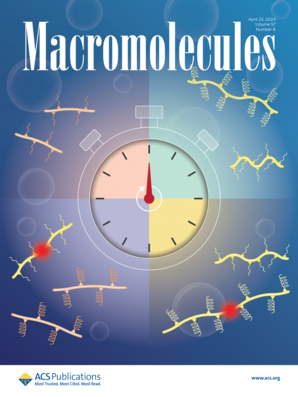Epitaxial Crystallization-Driven Self-Assembly of Block Copolymers with Asymmetric Stereoblock Polylactides into 3-D Triangular Prisms
IF 5.1
1区 化学
Q1 POLYMER SCIENCE
引用次数: 0
Abstract
The crystallization-driven self-assembly (CDSA) of block copolymers (BCPs) with crystallizable core-forming blocks typically produces low-dimensional nanostructures such as one-dimensional nanowires and two-dimensional platelets. This occurs because the solvent-soluble polymer blocks passivate a significant portion of the surface of the crystalline core. In this study, we report the formation of three-dimensional triangular prisms through the epitaxial CDSA of BCPs with asymmetric stereoblock polylactide, specifically [(d-lactide)32-(l-lactide)16]-b-PEG45. The iterative exponential growth (IEG) of enantiopure lactides into stereochemically sequence-defined polylactides results in the formation of [DLA32-LLA16]. The programmed chain folding of the stereochemically sequence-defined [DLA32-LLA16] block via intramolecular stereocomplexation between size-matched enantiomeric oligo(lactide) domains allows the excess [DLA16] domain to coexist with the stabilizing poly(ethylene glycol) (PEG) blocks on the top and bottom surfaces of the triangular core (approximately 9 nm in thickness) formed by the CDSA of this BCP. These surface-exposed homochiral [DLA16] domains serve as nucleation sites for the epitaxial growth of the triangular cores into triangular prisms with thickness exceeding 600 nm. We determined that the concentration-dependent kinetics of chain folding and crystallization of the asymmetric stereoblock polylactide, steric passivation by surface-located PEG chains, and the enantiopurity of the protruding oligolactide domains are critical factors that enable epitaxial CDSA.

外延结晶驱动嵌段共聚物与不对称立体嵌段聚乳酸自组装成三维三角形棱镜
嵌段共聚物(bcp)的结晶驱动自组装(CDSA)具有可结晶的核心形成块,通常产生低维纳米结构,如一维纳米线和二维血小板。这是因为溶剂溶性聚合物块钝化了晶核表面的很大一部分。在这项研究中,我们报道了不对称立体嵌段聚丙交酯,特别是[(d-丙交酯)32-(l-丙交酯)16]-b- peg45的bcp通过外延CDSA形成三维三角形棱镜。对映纯丙交酯的迭代指数增长(IEG)形成立体序列定义的聚丙交酯,形成[DLA32-LLA16]。通过大小匹配的对映体寡聚物(丙交酯)结构域之间的分子内立体络合作用,对立体化学序列定义的[DLA32-LLA16]结构域进行了程序化的链折叠,使得多余的[DLA16]结构域与由该BCP的CDSA形成的三角形核(厚度约9 nm)的上下表面的稳定聚乙二醇(PEG)区共存。这些表面暴露的同手性[DLA16]结构域作为三角形芯外延生长成厚度超过600 nm的三角形棱镜的成核位点。我们确定了不对称立体嵌段聚乳酸的链折叠和结晶的浓度依赖动力学,表面定位的PEG链的空间钝化以及突出的寡聚乳酸结构域的对映不透明性是实现外延CDSA的关键因素。
本文章由计算机程序翻译,如有差异,请以英文原文为准。
求助全文
约1分钟内获得全文
求助全文
来源期刊

Macromolecules
工程技术-高分子科学
CiteScore
9.30
自引率
16.40%
发文量
942
审稿时长
2 months
期刊介绍:
Macromolecules publishes original, fundamental, and impactful research on all aspects of polymer science. Topics of interest include synthesis (e.g., controlled polymerizations, polymerization catalysis, post polymerization modification, new monomer structures and polymer architectures, and polymerization mechanisms/kinetics analysis); phase behavior, thermodynamics, dynamic, and ordering/disordering phenomena (e.g., self-assembly, gelation, crystallization, solution/melt/solid-state characteristics); structure and properties (e.g., mechanical and rheological properties, surface/interfacial characteristics, electronic and transport properties); new state of the art characterization (e.g., spectroscopy, scattering, microscopy, rheology), simulation (e.g., Monte Carlo, molecular dynamics, multi-scale/coarse-grained modeling), and theoretical methods. Renewable/sustainable polymers, polymer networks, responsive polymers, electro-, magneto- and opto-active macromolecules, inorganic polymers, charge-transporting polymers (ion-containing, semiconducting, and conducting), nanostructured polymers, and polymer composites are also of interest. Typical papers published in Macromolecules showcase important and innovative concepts, experimental methods/observations, and theoretical/computational approaches that demonstrate a fundamental advance in the understanding of polymers.
 求助内容:
求助内容: 应助结果提醒方式:
应助结果提醒方式:


